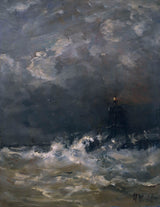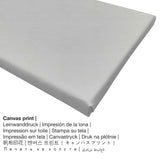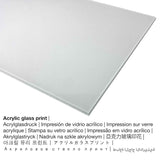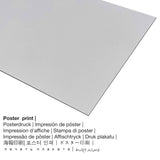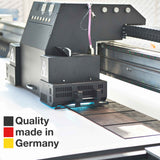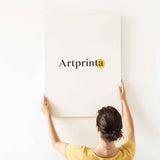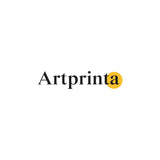Hendrik Willem Mesdag, 1900 - Ụlọ ọkụ na Breaking Waves - ọmarịcha nka
Ụtụ gụnyere. Mbupu gbakọrọ na ndenye ọpụpụ.
Nkọwa ngwaahịa nka
Ọrụ nka nke narị afọ nke 20 Lighthouse in Breaking Waves mere site na onye echiche artist Hendrik Willem Mesdag n’afọ 1900. Ihe ọzọ, a artwork bụ na nchịkọta nke Rijksmuseum. Site n'ikike nke Rijksmuseum (public domain license).Also, the work of art has the creditline: . In addition to that, the alignment of the digital reproduction is in Eserese format na nwere akụkụ ruru nke 3: 4, nke pụtara na ogologo bụ 25% mkpụmkpụ karịa obosara. The painter, art collector Hendrik Willem Mesdag was an artist from the Netherlands, whose style can be classified as Impressionism. The European painter was born in 1831 in Groningen, Groningen province, Netherlands and deceased at the age of 84 n'afọ 1915.
(© - site na Rijksmuseum - Rijksmuseum)
From 1870 the fishing village of Scheveningen grew rapidly into a modern seaside resort. Mesdag, however, rarely depicted the boulevard, or the new harbour that was built in 1904. He preferred to paint the traditional life of fishermen. This picture is an exception: a light-house, or rather a beacon. Signal lights, piers and the lighthouse were installed in Scheveningen only in the early 20th century.
Nkọwa nka ahaziri
| Aha nka: | "Lighthouse in Breaking Waves" |
| Nhazi: | sere |
| Okwu mkpokọta: | nkà nke oge a |
| Century: | 20th narị afọ |
| Emepụtara n'afọ: | 1900 |
| Afọ nka: | ihe karịrị afọ 120 |
| Ụlọ ihe ngosi nka: | Rijksmuseum |
| Ebe ngosi nka: | Amsterdam, Netherlands |
| Weebụsaịtị ihe ngosi nka: | Rijksmuseum |
| License: | ngalaba ọha |
| Site n'aka: | Rijksmuseum |
Tebụl nchịkọta ihe nkiri
| aha: | Hendrik Willem Mesdag |
| Aha ndị ọzọ: | mesdag h.w., Mesdag, Henrik William Mesdag, Mesdag Henrik Willem, H. W. Mesdag, W. Mesdag, Mesdag H. W., Mesdag Henrik William, h.w. mesdag, Hendrik Willem Mesdag, Mezdag Hendrick Willem, henrik willem mesdag, mesdag hendrik willem, mesdag h.w., Mesdag Henrick Willem, Mesdag Hendrik Willem, Mesdag Hendrik, Hendrik Wilhelm Mesdag |
| Gender: | nwoke |
| Obodo onye nka: | Dutch |
| Ọrụ onye na-ese ihe: | onye na-anakọta nka, onye na-ese ihe |
| Mba onye si: | mba netherland |
| Nhazi nke onye nka: | omenkà nke oge a |
| Ụdị nke onye na-ese ihe: | Mmetụta |
| Afọ ọnwụ: | 84 afọ |
| Amụrụ n'afọ: | 1831 |
| Ebe amụrụ onye: | Groningen, Groningen Province, Netherlands |
| Nwuru: | 1915 |
Họrọ ngwa ngwaahịa ịchọrọ idowe n'ụlọ gị
Anyị na-enye ihe dị iche iche dị iche iche na nha maka ngwaahịa ọ bụla. Ka ị kwekọọ n'ihe ị chọrọ nke ọma, ị nwere ike họrọ n'ime nhọrọ nhazi ngwaahịa ndị a:
- Aluminom dibond (ọkpụkpụ ọla): An Aluminium Dibond print is a print material with a true effect of depth. For your Aluminium Dibond print, we print your favorite artwork onto the aluminium composite surface. The direct print on aluminium is the most popular entry-level product and is a modern way to showcase fine art prints, as it draws focus on the whole artwork.
- Mbipụta akwụkwọ mmado (akwa akwa akwa): The Artprinta poster is a UV printed flat canvas with a fine texture on the surface, which reminds the original work of art. Please keep in mind, that depending on the size of the poster print we add a white margin of something between 2-6cm round about the artwork in order to facilitate the framing with a custom frame.
- Kwaaji: The canvas print, which should not be mistaken with a painting on a canvas, is an image printed from an industrial printing machine. The great advantage of canvas prints is that they are relatively low in weight. This means, it is easy to hang up the Canvas print without extra wall-mounts. Therefore, canvas prints are suitable for any type of wall.
- Bipụta na iko acrylic na-egbuke egbuke: The acrylic glass print, which is sometimes described as a plexiglass print, makes your favorite original work of art into beautiful home décor. Your own replica of the artwork is manufactured with the help of state-of-the-art UV printing technology.
Nkọwa ngwaahịa
| Nkewa ngwaahịa: | ọrụ mgbidi |
| Mmeputakwa: | dijitalụ mmeputakwa |
| Usoro mmepụta: | mbipụta dijitalụ (Mbipụta UV ozugbo) |
| Nlụpụta: | German mere |
| Ụdị ngwaahịa: | a na-achọ |
| A na-atụ aro iji ngwaahịa eme ihe: | nka mgbidi, foto mgbidi |
| Nhazi: | nhazi ihe osise |
| Oke akụkụ: | 3: 4 |
| Akụkụ onyonyo pụtara: | ogologo bụ 25% mkpụmkpụ karịa obosara |
| Akwa ngwaahịa dị: | Mpempe akwụkwọ, akwụkwọ mmado (akwụkwọ akpa), mbipụta enyo acrylic (nwere ezigbo mkpuchi iko), mbipụta ọla (aluminium dibbond) |
| Canvas dị n'elu ihe nrịbama (mbipụta kanvas) nha dị iche iche: | 30x40cm - 12x16", 60x80cm - 24x31", 90x120cm - 35x47", 120x160cm - 47x63" |
| Mpempe iko acrylic (nwere ezigbo mkpuchi iko) nha: | 30x40cm - 12x16", 60x80cm - 24x31", 90x120cm - 35x47" |
| Ụdị akwụkwọ mmado (akwụkwọ kwaaji) dị iche iche: | 30x40cm - 12x16", 60x80cm - 24x31", 90x120cm - 35x47" |
| Nhọrọ nha mbipụta aluminium dibond: | 30x40cm - 12x16", 60x80cm - 24x31", 90x120cm - 35x47" |
| Igwe onyonyo: | adịghị |
Ozi dị mkpa: We try what we can to depict the products as exact as possible and to illustrate them visually on the various product detail pages. Although, the colors of the print products and the print result can vary somehwat from the presentation on your screen. Depending on your settings of your screen and the nature of the surface, not all colors can be printed as exactly as the digital version. Bearing in mind that all art prints are processed and printed by hand, there may also be slight discrepancies in the motif's exact position and the size.
© Nchekwa ikike nwebisiinka | Artprinta (www.artprinta.com)

